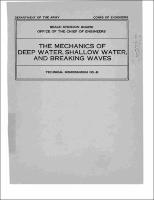Please use this identifier to cite or link to this item:
https://hdl.handle.net/11681/3422Full metadata record
| DC Field | Value | Language |
|---|---|---|
| dc.contributor | United States. Army. Office of the Chief of Engineers | - |
| dc.contributor | United States. Office of Naval Research | - |
| dc.contributor | University of California, Berkeley | - |
| dc.contributor.author | Morison, Jack R. | - |
| dc.contributor.author | Crooke, R. Curtis | - |
| dc.date.accessioned | 2016-03-16T15:42:34Z | - |
| dc.date.available | 2016-03-16T15:42:34Z | - |
| dc.date.issued | 1953-03 | - |
| dc.identifier.uri | http://hdl.handle.net/11681/3422 | - |
| dc.description | Technical Memorandum | - |
| dc.description | Abstract: Experimental data are presented for deep water, shallow water, and breaking waves with respect to the wave surface time history, the horizontal and vertical particle velocities and the particle orbits. The measurements are compared where applicable to Stokes wave theory. The results are that the Stokes wave theory (1,2,3,4)* and other wave theories (2,3,4) show good agreement with the measurements for deep water conditions and even to d/L values of approximately 0.2. The theories do not apply for shallow water oonditions where d/L values are appreciably less than 0.2 and the waves have an appreoiable steepness. | - |
| dc.publisher | United States, Beach Erosion Board | - |
| dc.publisher | Engineer Research and Development Center (U.S.) | - |
| dc.relation | http://acwc.sdp.sirsi.net/client/en_US/search/asset/1007561 | - |
| dc.relation.ispartofseries | Technical memorandum (United States. Beach Erosion Board) ; no.40. | - |
| dc.rights | Approved for Public Release, Distribution is Unlimited | - |
| dc.source | This Digital Resource was created from scans of the Print Resource | - |
| dc.subject | Deep Water Waves | - |
| dc.subject | Shallow Water Waves | - |
| dc.subject | Breaking Waves | - |
| dc.subject | Stokes Wave Theory | - |
| dc.title | The mechanics of deep water, shallow water, and breaking waves | - |
| dc.type | Report | en_US |
| Appears in Collections: | Technical Memorandum | |
Files in This Item:
| File | Description | Size | Format | |
|---|---|---|---|---|
| BEB-TM-40.pdf | 8.6 MB | Adobe PDF |  View/Open |